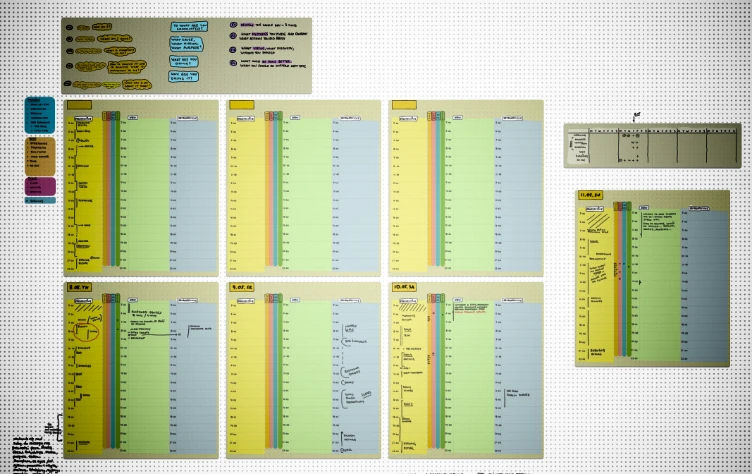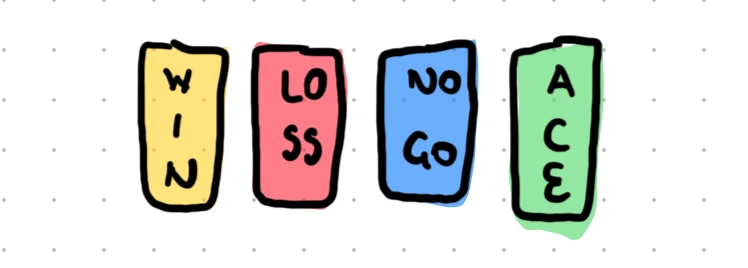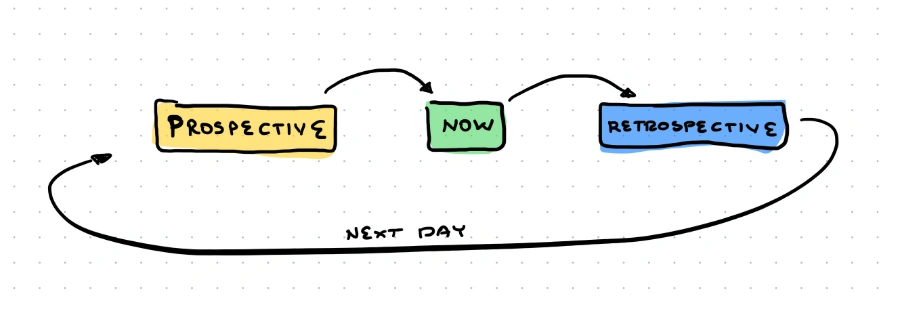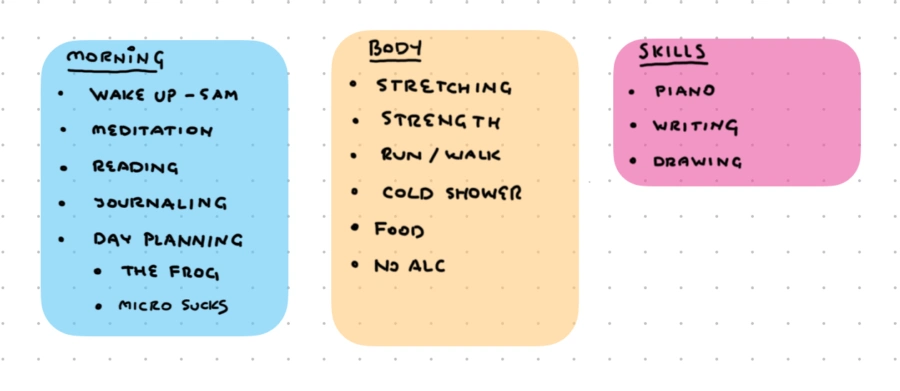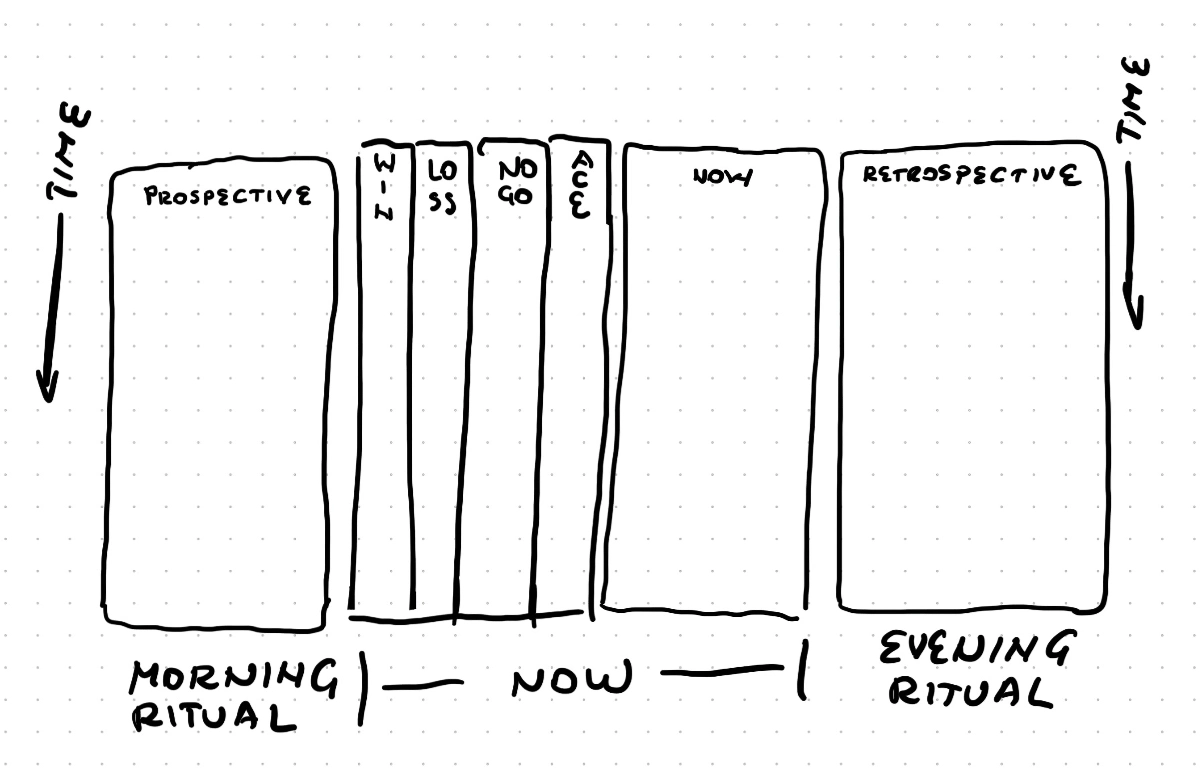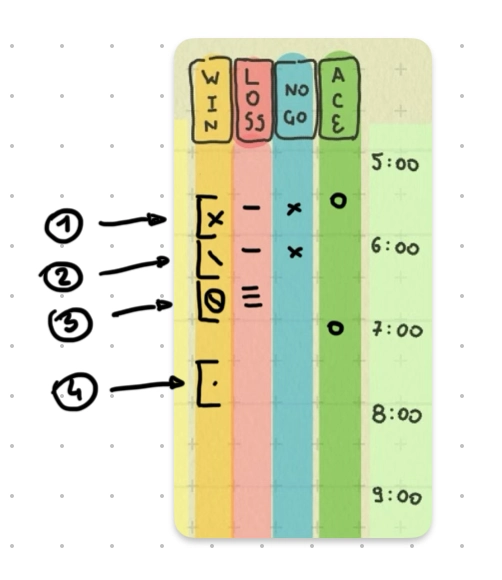Mindful Productivity
A Personal Framework for Intentional Productivity and Self-Regulation
I’m not the only one who loves notebooks and enjoys taking notes. Like many of us, it’s a constant element of my everyday life, a moment when it’s just me, my own thoughts, and a sheet of paper. Sometimes the paper is replaced by a tablet, that’s true, but it’s always the work of my hand, drawing each letter, composing words, sentences… It’s slower, but perhaps this moment of serenity, of slowing down the race of my own thoughts - that’s what this is really all about.
Daily note-taking has become for me, on one hand, a way to build a structured self-regulation loop, and on the other hand, a method for planning and productivity. Along the way, I’ve drawn from various ideas, starting from the The Eisenhower Matrix and ending with Bullet Journal (by Ryder Carroll) - mixing, trimming, adapting, and testing on myself. What I describe below took its current form about 4-5 years ago and hasn’t undergone any significant changes since. If in any way what works for me proves useful for you as well - I’ll be more than happy.🤗
The Architecture of Attention: A Four-Element System for Mindful Productivity
At the heart of my daily practice lies a system built around four integrated elements that form the architecture of how I manage attention throughout my day: WIN-LOSS-NOGO-ACE.
🟡 WIN
WIN (What’s Important Now)1 represents a chunk/box of focused work - 30-minute time blocks2 where I commit to being fully present with what truly matters. But unlike traditional time management techniques, WIN isn’t just about productivity; it’s about intentionality, about declaring “this is what deserves my full attention right now”.
Purpose:Intentional 30-min focus block
Mindset:Commitment to what matters now
Psychological Basis:Time Management
Supported Benefits:Enhanced focus and productivity
🔴 LOSS
But focus isn’t a straight line. Distractions inevitably arise, which is where LOSS (Log of Spontaneous Slips) comes in. But rather than battling distractions with willpower alone, I acknowledge them by briefly noting each interruption - creating awareness without judgment, capturing the mind’s wanderings as they occur.
I remember that the beginning was difficult, and catching each Slip was often delayed, for example, only after finishing WIN (being called back to NOW by the timer), was I able to determine that I had spent perhaps 15 minutes reading some unnecessary news. But, and this is important - even doing this after the fact, we are training our neural networks, and with time this process will happen almost instantaneously. By practicing LOSS, we create what’s called a disenchantment database3, actively updating our internal “database” to reflect the true nature of these behaviors (distractions). Over time, this practice can diminish the perceived reward of the distractions, making them less compelling. It’s worth mentioning that in Buddhist tradition, there exists the concept of Māra4, which aligns with what I have personally called LOSS.
Purpose:Distraction or slip
Mindset:Awareness without judgment
Psychological Basis:Metacognitive Awareness
Supported Benefits:Improved self-regulation
🔵 NOGO
The magic happens in the NOGO (Not Going There) moments - those small victories where I recognize a distraction (LOSS) and consciously choose to redirect my attention. Each NOGO represents the strengthening of my attention muscles, a micro-decision that shapes how I engage with the world. NOGO is also a conscious restraint from performing an action that may have already become automatic - such as: reaching for a snack, refreshing a news page or social media once again etc. etc.
Purpose:Noticing & resisting distraction
Mindset:Empowerment, clarity
Psychological Basis:Inhibitory Control
Supported Benefits:Better attention and emotional balance
🟢 ACE
Finally, ACE (Acknowledge, Come back to the body, Engage with environment)5 serves as my reset button - a brief somatic grounding practice that reconnects mind with body when focus has fragmented. This technique, developed by Dr. Russ Harris, helps me rapidly regain my center when distractions overwhelm. When I lose focus, I simply acknowledge whatever thoughts or feelings are present without judgment, come back to physical sensations in my body (like feeling my feet on the floor or taking a deep breath), and then engage with my environment by noticing what I can see, hear, or touch right now. While some might prefer the similar RAIN technique (Recognize, Allow, Investigate, Nurture) popularized by Tara Brach, I’ve found ACE to be more immediate and actionable in the midst of busy workdays.
In a nutshell, the ACE technique works as follows:
- A - Acknowledge your thoughts and feelings as they are, without judgment
- C - Come back to your body by noticing physical sensations, your breath, or how your body feels in space
- E - Engage with your environment by connecting with what’s around you through your senses
This creates a powerful dropping anchor effect that grounds you in the present moment when your attention has drifted, allowing you to return to your WIN (What’s Important Now) with renewed focus and presence.
Purpose:Grounding/reset
Mindset:Reconnection with body and now
Psychological Basis:Grounding Techniques
Supported Benefits:Reduced stress and improved presence
Together, these four elements flow throughout my day, nested between morning Prospective planning and evening Retrospective reflection.
The Daily Rhythm: Prospective and Retrospective
Each day unfolds between two intentional rituals. In the morning, I engage in what cognitive scientists call Prospective thinking - a deliberate planning ritual where I map out my day in focused blocks. This isn’t merely scheduling but it’s setting implementation intentions6 that prime my brain for focused work before the day’s demands begin to tax my executive function.
And as the day closes, I return to my notes for the Retrospective ritual - a practice with roots in Stoic philosophy. This evening review isn’t just about checking off completed tasks; it’s a meaningful reflection where I examine patterns in my distractions, celebrate moments of focus, and extract wisdom from both successes and challenges. This creates a powerful feedback loop, as tonight’s insights directly inform tomorrow’s Prospective planning.
Morning Ritual: Foundations of Prospective Thinking
My morning ritual begins at 5 AM, a time when the world is still quiet and my mind hasn’t yet been pulled in multiple directions. Part of this ritual is connected to my former fascination with Hal Elrod’s “Miracle Morning”7, though with my own modifications. It includes several foundational elements that prepare both my mind and body:
- Early Wake-up: Avoiding internet use for at least 1.5 hours
- Meditation: A brief mindfulness practice to center attention
- Reading: Engaging with meaningful content (often philosophical texts)
- Journaling: Responding to my five morning questions
- Planning: arrange the entire structure of my day
These five questions form the heart of my Prospective phase:
-
“Who am I?” - This question grounds me in my core identity and values, reconnecting me with what matters most before the day’s demands create amnesia about what’s truly important.
-
“Where am I going?” - By revisiting my direction and trajectory, I ensure that today’s actions align with my longer-term path, preventing the tyranny of the urgent from displacing the important.
-
“What is important to me?” - This directly informs which activities deserve WIN blocks in my day, creating an intentional hierarchy of attention rather than responding reactively to whatever arises.
-
“How to change my life to achieve what is important to me?” - This bridges philosophical reflection with practical strategy, helping me identify not just what matters but what actions will move me toward it.
-
“What can I do about it today?” - The most immediate and actionable question, transforming broader reflections into specific WIN blocks for the day ahead.
After engaging with these questions, I complete my planning. First, I build the structure for the entire day, then, if required, I identify my "frogs" - those challenging tasks that would be easy to avoid but would create the most meaningful progress. Following Brian Tracy’s advice to “eat that frog” 8, I schedule these difficult tasks early in my day when my executive function is strongest.
I also maintain a list of personal activities that I try to repeat daily or several times a week, which I take into account during planning. Below is an example list of regular elements from which I select and add to my daily plan (and thereby track their implementation):
I track all these morning elements in my NOW column (which I’ll explain shortly), creating accountability for these foundational practices. The completion of this ritual signals a clear transition - I’ve engaged in Prospective thinking and am now prepared to navigate the day with intention rather than reaction.
Evening Ritual: The Art of Retrospective Reflection
As the day winds down, I return to my notebook for the evening ritual - a practice inspired by Seneca’s advice to “review your day” before sleep. This isn’t merely about recording what happened but about extracting wisdom from experience.
My Retrospective is guided by four core actions:
-
“Review the whole day - 3 times” - This initial pass through the day’s events creates cognitive distance, allowing me to see patterns I might have missed while immersed in them.
-
“What mistakes you made and condemn what actions you did badly” - This honest assessment isn’t about self-criticism but about clear-eyed recognition. I pay particular attention to my LOG of Spontaneous Slips (LOSS), looking for triggers or patterns.
-
“What virtue, what strength, wisdom you showed” - This positive reflection acknowledges successes, particularly NOGO moments when I successfully redirected my attention. Celebrating these small victories reinforces neural pathways of attention management.
-
“What could be done better, what you should do instead next time” - This forward-looking question transforms today’s experience into tomorrow’s strategy, completing the feedback loop between
RetrospectiveandProspectivethinking.
At the end of my evening session, I always try to calm my body and mind. A good idea here might be the 4-7-8 Breathing technique (ProsoEase app), body scan meditation, or even ACE but as a quieter and longer session.
The Notebook System: Where Philosophy Meets Practice
All right, we now have all the puzzle pieces, each with its own scientific foundation, but what can we actually do with this? Below, allow me to present to you my own visual system, showing how I’ve combined all these puzzle pieces into something concrete.
My daily tracking page is divided into three primary columns, each with a distinct purpose:
-
PROSPECTIVE Column (left) - where morning planning occurs
-
NOW Column (middle) - serves as space for quick notes about what’s actually happening, insights that arise, or context about distractions
-
RETROSPECTIVE Column (right) - reserved for evening reflection
My page is also divided into rows, from top to bottom, with each row representing a 30-minute time block.
Between the Prospective and NOW columns, I’ve added four narrow tracking columns that form the core of my attention monitoring system:
WIN | LOSS | NOGO | ACE
- Ad 1 - WIN block completed
- Ad 2 - WIN block started
- Ad 3 - incomplete WIN (failed) - for example when there were too many distractions
- Ad 4 - WIN block allocation
- LOSS - each distraction or attention slip is marked with a simple “-“ at the corresponding time
- NOGO - when I successfully catch and redirect a distraction, I mark an “x”
- ACE - moments of intentional grounding through the ACE practice are noted with a small “o” mark
Together, all these create a cycle of increasing awareness and intention. The Prospective phase sets direction, the NOW phase (with WIN-LOSS-NOGO-ACE) provides real-time awareness, and the Retrospective phase extracts learning - which then informs the next day’s Prospective thinking.
So this is what it looks like in practice, my daily notebook page.
Closing Thoughts
That concludes my introduction to this mindful productivity system. What began as personal experimentation has evolved into a structured framework with scientific underpinnings - a system that balances intentionality with awareness, planning with reflection.
I’ve merely scratched the surface here, introducing the core concepts and basic implementation. For those interested in exploring this system further, I plan to develop additional resources in the future - deeper dives into each component, practical templates, and strategies for adapting the framework to different lifestyles and needs.
Whether you adopt this system in its entirety or simply borrow elements that resonate with you, I hope it sparks reflection on how intentionally you’re directing your most precious resource - your attention. In a world designed to fragment our focus, perhaps the most radical act is creating space to decide, moment by moment, what truly deserves our awareness.
Thank you for joining me on this exploration, and I look forward to sharing more developments with those who find this approach valuable.
-
I adapted the WIN concept itself from legendary Notre Dame football coach Lou Holtz ↩
-
The idea of 30-minute time blocks is borrowed from the Pomodoro Technique by Francesco Cirillo ↩
-
rooted in both Buddhist psychology and neuroscience; a term popularized by Dr. Judson Brewer ↩
-
In Buddhist tradition, Māra is often described as the force of distraction, temptation, fear, doubt, and all that pulls one away from clarity, awareness, and liberation. But Māra is not just a “devil” figure - it’s more nuanced: Māra is what the mind does to avoid being present. ↩
-
ACE was developed by Dr. Russ Harris as part of Acceptance and Commitment Therapy (ACT). You can learn more about this approach at Dr. Harris’s website. ↩
-
The seminal paper introducing implementation intentions: Gollwitzer, P. M. (1999). Implementation intentions: Strong effects of simple plans. American Psychologist, 54(7), 493-503. ↩
